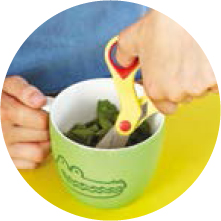
Now we are almost ready to start. There are lots of skills to learn but every recipe tells you exactly what to do at every step. On the following pages, we give you a bit more information on techniques that are used time and time again.
You will be chopping fresh herbs and tomatoes with scissors. To do this safely, put what you are chopping into a cup or mug, hold the cup handle firmly with one hand, then put the blades of the scissors into the cup and chop away. Your hands are holding the cup or the scissors so there’s no chance of snipping yourself.

Egg shells are very clever. Their shape makes them very strong, which is why you might find cracking an egg a bit tricky at first. Put a cup or small bowl with a handle on the work surface. Hold the handle tightly with one hand and the egg firmly with the other, then tap the egg in the middle against the edge of the cup a couple of times. Listen. The sound will change when the egg cracks. Now hold the egg over the top of the cup with both hands and push your thumbs into the crack. Pull your thumbs apart slowly so that the egg drops out into the cup or bowl.
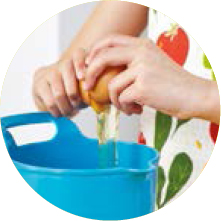
If you have food allergies, check the labels if you are using unfamiliar ingredients. Try the recipes with your usual ingredient replacements and you should still be able to enjoy a global experience.
When filling loaf pans, cake papers or moving a mixture from the bowl, use this two-spoon method. Take a spoonful of the mixture. Put the loaded spoon low over where you want to drop the mixture and push it off using a second spoon.
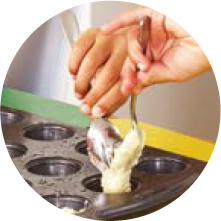
You may want to ask an adult to help you as graters are very sharp. Hold the grater by the handle and, keeping your fingers away from the grater, rub the block of cheese, the carrot or the fruit down the blades. 
To stop food sticking to baking pans, drip a few drops of oil on the pan, then brush it over the surface using a pastry brush or a piece of paper towel.
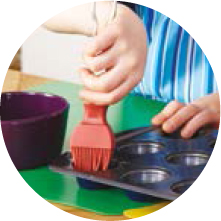
Cut a piece of baking parchment to the size of the baking sheet and lay it on top. If you brush a little oil on the sheet first, it will keep the baking parchment in place. Use shaped cake-pan or loaf-pan liners.
Try out new techniques, such as popping a pepper or topping and tailing! Spring onions/scallions are great for adding onion flavour without having to use a sharp knife to cut the onion first.
Measure
To measure liquids, if you have a jar, get the spoon really full by tipping the container and sliding the spoon fully in. It is easy to fill a spoon from a squeezy bottle. We measure over a plate or bowl to catch any drips. To measure dry ingredients, scoop the ingredients into the spoon, then gently pat the top flat with the palm of your hand.
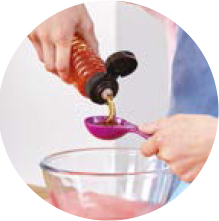
Using a fork, whisk or wooden spoon, stir and mix the ingredients together so they are all muddled up.
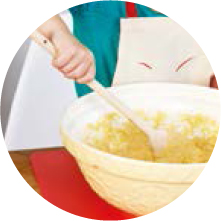
Put a whole pepper on a cutting board with the stalk facing up. Place your thumbs on the top of the stalk, then push them down firmly to ‘pop’ the pepper. Tear it open with your thumbs and use your fingers to remove the seeds. Now tear it up or use scissors to cut it into pieces.
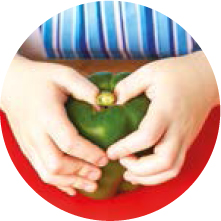
Clean the spring onion/scallion in cold water, then trim off the roots at the white end (the tail), using scissors. Trim off the very dark leaves at the other end (the top). Now cut the rest of the onion into small rings – keep the point of the scissors low to the surface of your cutting board and the onion shouldn’t spring too much! Put the top and tail in the compost or bin.